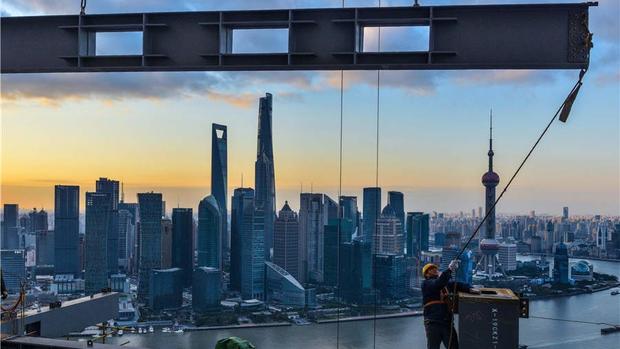 Raffles City on the North Bund, Tilan Bridge area, Hongkou district, Shanghai (263 meters high, 50 floors). Structure installation workers hoist steel components. (HU ZHIMIN / FOR CHINA DAILY)
Raffles City on the North Bund, Tilan Bridge area, Hongkou district, Shanghai (263 meters high, 50 floors). Structure installation workers hoist steel components. (HU ZHIMIN / FOR CHINA DAILY)
BEIJING - China has set a sound growth target for 2021, leaving room for policymakers to carry out arduous reforms to tackle bottlenecks constraining sustainable development.
"A target of over 6 percent (of economic growth) will enable all of us to devote full energy to promoting reform, innovation, and high-quality development," Premier Li Keqiang said in the government work report delivered to the national legislature, which began its annual session Friday.
China will raise its capacity for pursuing scientific and technological innovation, leveraging market forces to encourage enterprises to innovate
The report, along with the draft blueprint setting the country's development priorities for the period up to 2035, both of which are being discussed at the annual "two sessions" of the country's top legislature and political advisory body, outlined key areas where reforms are expected to bring institutional changes and bolster the country's long-term growth.
Building Up Tech Strength
China will raise its capacity for pursuing scientific and technological innovation, leveraging market forces to encourage enterprises to innovate, according to the report.
To that end, the country will offer preferential tax policies to encourage research and development (R&D), especially for manufacturing enterprises, the report said.
ALSO READ: China's foreign trade surges 32.2% in first two months
The draft outline of the 14th Five-Year Plan (2021-2025) for national economic and social development and the long-range objectives through the year 2035 also identified self-reliance in science and technology as a strategic underpinning for national development.
Guo Wei, deputy director of the Research Office of the State Council, said that the building of tech strength is a sustained process that requires efforts from all parties, and market-oriented mechanisms are necessary to incentivize more R&D spending by firms.
Liu Wei, a national political advisor and chairman of Guangzhou-based artificial intelligence (AI) provider PCITECH, said that, while the country already enjoys a competitive edge globally in fields such as AI-powered transport and medical services, the application scenarios for the technology are still limited.
He proposed that the government and state-owned enterprises work with private companies to apply AI technology in areas like smart cities and urban rail transit.
ALSO READ: China targets GDP growth of more than 6 percent in 2021
China's advancement in technology will not only be crucial for its own growth, but offers benefits to the wider world, breaking the technology monopoly by many developed countries and lowering the prices of key technologies, said Li Daokui, an economist with Tsinghua University and a national political advisor.
Tapping Consumption Potential
China will take expanding domestic demand as a strategic move and fully tap the potential of the domestic market, according to the report.
The move is in line with the country's prolonged transition from an investment-driven growth model to one that depends more on domestic demand, which is considered more able to withstand external shocks.
The reform on expanding domestic demand does not only mean short-term consumption stimulus, but improvements in mechanisms, including integrated urban-rural development and income distribution, analysts said.
Liu Shangxi, head of the Chinese Academy of Fiscal Sciences and a national political advisor, said that both demand-side and supply-side reforms are needed to unleash the country's consumption potential.
Liu Shangxi, head of the Chinese Academy of Fiscal Sciences and a national political advisor, said that both demand-side and supply-side reforms are needed to unleash the country's consumption potential
"It's not enough just to put more money into people's pockets to foster domestic demand. The demand is created only when there is something that people are willing to spend money on," he said.
ALSO READ: Blueprint of five-year plan charts key development projects
To that end, reforms must be carried out so that resources such as land, labor and data are allocated according to market principles, Liu said.
He Lifeng, head of the country's top economic planning body, said that the country will take various measures to increase people's incomes, while at the same time creating more quality products on the supply side.
Speeding Up Green Transition
A moderate GDP target would also give officials room to push the green transformation of many industries, which is often considered unlikely to generate immediate economic gains.
China will stay true to the principle that lucid waters and lush mountains are invaluable assets and promote green development, Premier Li said in the government work report.
Pursuing an eco-friendly growth pattern over the years, the country has taken multiple measures to promote the wider use of renewable energy, cut the production capacity of resource-intensive sectors and wage a battle against pollution.
Official statistics show that by 2019, carbon emission intensity in China had decreased by 48.1 percent compared with 2005, exceeding the target of reductions in carbon emission intensity by 40 to 45 percent between 2005 and 2020.
In 2021, energy consumption per unit of GDP and carbon dioxide emissions per unit of GDP will be reduced by 13.5 percent and 18 percent, respectively, according to the report.
ALSO READ: Li: New 5-Year Plan to focus on growth
The government will also draw up an action plan for peaking carbon emissions before 2030 and make efforts to improve its industrial structure and energy mix, the report said.
Zhang Ming, a researcher with the Chinese Academy of Social Sciences, said that the country is expected to adopt more stringent targets on energy conservation in the context of peaking carbon emissions and achieving carbon neutrality.


